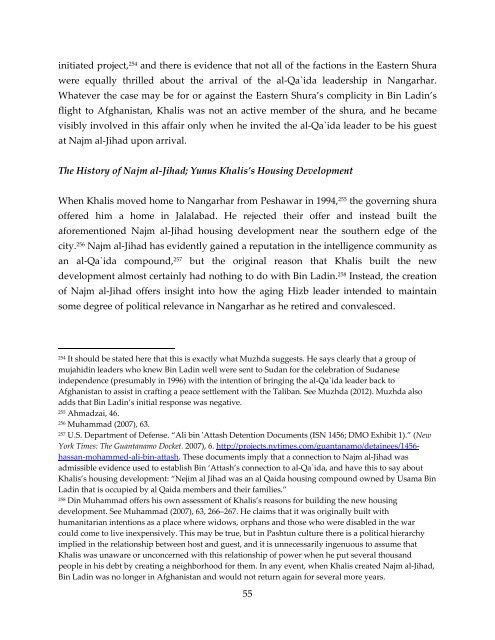Usama bin Ladin’s “Father Sheikh”:
Usama bin Ladin’s “Father Sheikh”:
Usama bin Ladin’s “Father Sheikh”:
You also want an ePaper? Increase the reach of your titles
YUMPU automatically turns print PDFs into web optimized ePapers that Google loves.
initiated project, 254 and there is evidence that not all of the factions in the Eastern Shura<br />
were equally thrilled about the arrival of the al‐Qa`ida leadership in Nangarhar.<br />
Whatever the case may be for or against the Eastern Shura’s complicity in Bin <strong>Ladin’s</strong><br />
flight to Afghanistan, Khalis was not an active member of the shura, and he became<br />
visibly involved in this affair only when he invited the al‐Qa`ida leader to be his guest<br />
at Najm al‐Jihad upon arrival.<br />
The History of Najm al‐Jihad; Yunus Khalis’s Housing Development<br />
When Khalis moved home to Nangarhar from Peshawar in 1994, 255 the governing shura<br />
offered him a home in Jalalabad. He rejected their offer and instead built the<br />
aforementioned Najm al‐Jihad housing development near the southern edge of the<br />
city. 256 Najm al‐Jihad has evidently gained a reputation in the intelligence community as<br />
an al‐Qa`ida compound, 257 but the original reason that Khalis built the new<br />
development almost certainly had nothing to do with Bin Ladin. 258 Instead, the creation<br />
of Najm al‐Jihad offers insight into how the aging Hizb leader intended to maintain<br />
some degree of political relevance in Nangarhar as he retired and convalesced.<br />
254 It should be stated here that this is exactly what Muzhda suggests. He says clearly that a group of<br />
mujahidin leaders who knew Bin Ladin well were sent to Sudan for the celebration of Sudanese<br />
independence (presumably in 1996) with the intention of bringing the al‐Qa`ida leader back to<br />
Afghanistan to assist in crafting a peace settlement with the Taliban. See Muzhda (2012). Muzhda also<br />
adds that Bin <strong>Ladin’s</strong> initial response was negative.<br />
255 Ahmadzai, 46.<br />
256 Muhammad (2007), 63.<br />
257 U.S. Department of Defense. “Ali <strong>bin</strong> ʹAttash Detention Documents (ISN 1456; DMO Exhibit 1).” (New<br />
York Times: The Guantanamo Docket. 2007), 6. http://projects.nytimes.com/guantanamo/detainees/1456‐<br />
hassan‐mohammed‐ali‐<strong>bin</strong>‐attash. These documents imply that a connection to Najm al‐Jihad was<br />
admissible evidence used to establish Bin ‘Attash’s connection to al‐Qa`ida, and have this to say about<br />
Khalis’s housing development: “Nejim al Jihad was an al Qaida housing compound owned by <strong>Usama</strong> Bin<br />
Ladin that is occupied by al Qaida members and their families.”<br />
258 Din Muhammad offers his own assessment of Khalis’s reasons for building the new housing<br />
development. See Muhammad (2007), 63, 266–267. He claims that it was originally built with<br />
humanitarian intentions as a place where widows, orphans and those who were disabled in the war<br />
could come to live inexpensively. This may be true, but in Pashtun culture there is a political hierarchy<br />
implied in the relationship between host and guest, and it is unnecessarily ingenuous to assume that<br />
Khalis was unaware or unconcerned with this relationship of power when he put several thousand<br />
people in his debt by creating a neighborhood for them. In any event, when Khalis created Najm al‐Jihad,<br />
Bin Ladin was no longer in Afghanistan and would not return again for several more years.<br />
55


